
Grab and Go, Go, Go
Global cuisine and the wellness and clean label movements are inspiring tremendous choice in handheld meals.
Article Content
As lunchtime approaches, the young tech worker weighs his options: “Should I microwave the frozen empanadas I brought from home? Should I grab a Mumbai-style wrap from the food truck across the street? Or should I walk four blocks to the new vegan sandwich shop?”
Across the United States and in many other parts of the world, urban Millennials in particular but also other busy, culinarily adventurous consumers wrestle with similar decisions. There has been an explosion of choice in the handheld category in both retail and foodservice—from fusion wraps and burgers with exotic toppings to meat-filled pastries and egg rolls the size of burritos (Packaged Facts 2015).
The proliferation of handhelds reflects the time crunch most everyone is under. “Portability has always been a top attraction of the handheld category, but what we’re seeing now is more messaging on packaging touting these products as convenient solutions for our busy, harried lifestyles,” notes Kara Nielsen, sales and engagement manager for Innova Market Insights. “In many parts of the world, people barely have time to leave their desks to eat lunch.”
Most sandwiches and other handheld entrées also satisfy the continuing consumer penchant for protein. While demand for animal-based protein is still strong and chicken remains the No. 1 sandwich ingredient internationally, according to Innova’s Nielsen, ongoing innovation in plant-based proteins has spurred diversity in the vegan handheld realm. Given the propensity of Millennials and other generations now to nosh throughout the day, smaller-portioned handheld meals can serve as ideal nutrient-dense snacks, no matter the protein source (Innova 2017).
Indeed, several trends have converged, some of them seemingly contradictory, to spark the amazing variety of handhelds available to consumers in 2017. Most important, the health and wellness and free-from movements are fueling the fast pace of global new product development in this space, observes Nielsen, noting that Innova tracks products in more than 80 countries.
“Among the products that you find in grocery stores and convenience stores around the world, we see many more sandwiches and wraps with clean label claims, such as ‘no additives’ and ‘no preservatives,’ as well as more ‘natural’ claims, sometimes also touting organic ingredients,” she says.
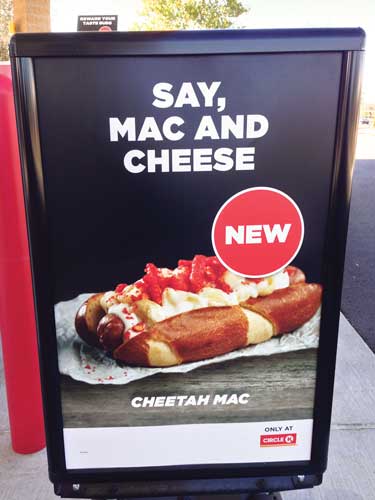 Yet, simultaneously, high-calorie indulgence has become more commonplace, at least in the United States. In the sandwich realm, this has led to over-stuffed, fat-laden restaurant creations such as Buffalo Wild Wings’ Cheese Curd Bacon Burger, which has 1,620 calories without the fries (Buffalo Wild Wings 2017). When it comes to fillings and toppings for handheld meals in the United States, spicy hot flavors vie with traditional American comfort foods—sometimes in the same sandwich, as is the case with Circle K’s Cheetah Mac, a hot dog topped with macaroni and cheese and partially melted Flamin’ Hot Cheetos.
Yet, simultaneously, high-calorie indulgence has become more commonplace, at least in the United States. In the sandwich realm, this has led to over-stuffed, fat-laden restaurant creations such as Buffalo Wild Wings’ Cheese Curd Bacon Burger, which has 1,620 calories without the fries (Buffalo Wild Wings 2017). When it comes to fillings and toppings for handheld meals in the United States, spicy hot flavors vie with traditional American comfort foods—sometimes in the same sandwich, as is the case with Circle K’s Cheetah Mac, a hot dog topped with macaroni and cheese and partially melted Flamin’ Hot Cheetos.
More significantly, as a result of multiculturalism, increased interest in international cuisine and the new preference of American consumers for authenticity, many sandwiches that were once limited to specific ethnic neighborhoods in the United States have been gaining new fans. One example is the Cubano, a hot-pressed sandwich similar to a panini that typically consists of layers of sliced roast pork, glazed ham, Swiss cheese, and thin-sliced pickles between slices of Cuban bread. Another is the Mexican torta, a sandwich eaten hot or cold in which a crusty white bolillo roll sliced in half grips a filling of meat, avocado, eggs, or beans that is garnished with a mixture of cucumbers, tomatoes, onions, cheese, and jalapeños and flavored with fresh-squeezed lime juice, spices, and seasonings (Packaged Facts 2015).
As with other categories, the foodservice sector is driving a lot of the handheld innovation in retail, with inspiration drawn from multiple sources such as Asian, African, and Latin American street food; the all-day breakfast sandwiches at McDonald’s and, more recently, Starbucks; and chef-prepared offerings in fast casual restaurants. But American food bloggers and other foodies who share their sandwich creations and discoveries via social media are also influencing the category.
DudeFoods.com’s Nick Chipman, for one, has received a lot of media attention and enthusiastic comments online for his whimsical inventions that transform popular American cuisine into novel handheld carriers and fillings. His Bacon Weave Taco, for instance, features interlaced bacon strips shaped into a shell that is filled with macaroni and cheese as well as typical taco ingredients. And his Reuben Sandwich Cone, in which the carrier is fashioned from circular slices of rye bread shaped with a waffle-cone forming tool, makes this classic deli sandwich easier to eat on the go (Dude Foods 2014).
Clearly, playful experimentation and consumers’ craving for ever more convenience are informing the handheld realm. But despite the surge in assortment within the category as a whole, growth has been flat to moderate for handhelds in the U.S. grocery sector. The refrigerated handheld non-breakfast entrée segment, a $1.6 billion subcategory, experienced the most growth in the past year, with retail dollar sales increasing 4.1% for all brands, according to data from IRI for the 52 weeks ending Aug. 13, 2017. Within this segment, sales of private brand products, accounting for 42% value share, rose 11.6% (IRI 2017). The relative strength of private brands makes sense because many U.S. supermarket chains today sell a variety of refrigerated grab-and-go sandwiches and wraps under the store’s brand.
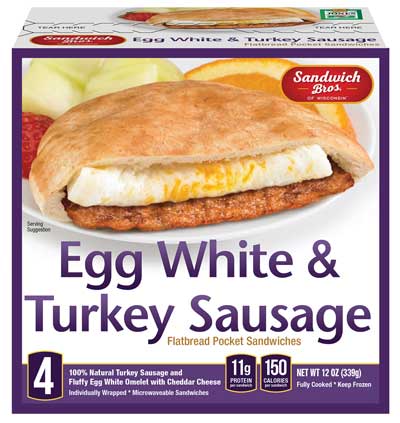 In the frozen handheld subcategory, the numbers barely budged. The non-breakfast entrée handheld segment grew just 0.3% in retail dollar sales, while the breakfast handheld segment rose by 1%. But within these categories, there were some star performers. For example, Kangaroo Brands’ Sandwich Bros. of Wisconsin frozen breakfast line climbed 86.2% in dollar sales, while frozen breakfast handhelds manufactured by Sweet Earth Natural Foods (recently purchased by Nestlé) increased 55.1%. In the frozen non-breakfast domain, private label handheld meals, a $141.8 million segment, grew a robust 20.1% (IRI 2017).
In the frozen handheld subcategory, the numbers barely budged. The non-breakfast entrée handheld segment grew just 0.3% in retail dollar sales, while the breakfast handheld segment rose by 1%. But within these categories, there were some star performers. For example, Kangaroo Brands’ Sandwich Bros. of Wisconsin frozen breakfast line climbed 86.2% in dollar sales, while frozen breakfast handhelds manufactured by Sweet Earth Natural Foods (recently purchased by Nestlé) increased 55.1%. In the frozen non-breakfast domain, private label handheld meals, a $141.8 million segment, grew a robust 20.1% (IRI 2017).
These figures reinforce other research showing that many consumers today, especially Millennials, view refrigerated meals as inherently fresher and more healthful than their frozen counterparts. But within the frozen space, some handheld products have earned kudos and sales for being nutrient-dense, minimally processed, and fresh-tasting.
Something for Everybody
The 2017 Innova Market Insights Sub-Category Report on Sandwiches reveals that Europe leads all other continents in handheld launch activity, accounting for 47% of all sandwich debuts in the second half of 2016—far ahead of North America with 24% and Asia with 13%. “The main focus of [handheld] launches is offering a convenient meal or snack option, either ready-to-eat or ready-to-heat (usually in a microwave), and suitable for consumption on the go,” states the report’s Executive Summary (Innova 2017).
Worldwide, most of the category’s product introductions are in the refrigerated realm, with many of the launches conventional-appearing sandwiches on white, whole wheat, or multigrain bread but which often have creative filling combinations. One example in the Innova report is from the United Kingdom: the Oakwood Smoked Ham & Coleslaw sandwich on white bread, a new addition to the Sainsbury’s On the Go line, which features more than 60 sandwiches, from Chicken & Sweetcorn to Salmon & Cucumber. Another example is from Finland, in Lidl’s Chef Select To Go line: a Gouda Sandwich with preserved tomato and remoulade sauce.
The UK’s Boots drugstore chain, a division of Walgreens Boots Alliance, offers three separate grab-and-go sandwich ranges (Boots 2017): Delicious (classic sandwiches), Nutritious (incorporating vegetables or fruit and a protein), and Shapers (low-calorie). This year, Boots debuted several sandwiches across these ranges, according to Nielsen: a Cuban-style pork, pineapple, and Emmenthal cheese sandwich on regular bread, a chicken salad sandwich on gluten-free bread, and a Jamaican-style sweet potato curry in a flatbread wrap are just a few of them.
“There is something for everybody,” Nielsen notes. Extensive sandwich lines, with nuanced ingredient variations, play to the mostly Millennial-driven trend toward wanting more personalized food products. While Europe has a bigger variety of ready-to-eat cold sandwiches, U.S. grocery retailers provide customization with made-to-order deli sandwiches and subs.
The Innova Market Insights report also showcases a number of refrigerated wraps that rolled out in 2016, many of which bring together components from vastly different ethnic cuisines. One product debuting in South Africa at the end of last year was Woolworths’ Pulled Smokey BBQ Beef Naanwiches, mini wraps made from the thick Indian flatbread naan, which include “a tangy sweet free-range mayonnaise, mozzarella cheese, and spring onion,” according to the packaging. In Norway, the bakery chain Mesterbakeren introduced the Caesar Chicken and Bacon Wrap on a flour tortilla. And in France, the retailer Monop Daily began offering “Mexican-style” flatbread sandwiches, two to a package, that are filled with chicken, red beans, and cheddar cheese (Innova 2017).
Pastries with Pizzazz
In the United States, internationally derived savory pastries with widely varying fillings are generating much of the excitement in the handheld category—at a time when Nestlé Lean Pockets have dropped 21% in dollar sales in the past year in the non-breakfast entrée segment and Hot Pockets have also declined slightly, according to IRI data (IRI 2017).
Caribbean Food Delights, for example, offers both mild and hot frozen Jamaican-style “beef patties” (filled turnovers), which are a popular Jamaican street food. Sold at Walmart, this product is not new but is gaining traction. Retail sales of Caribbean Food Delights’ handhelds increased nearly 13% in the past year, according to IRI (IRI 2017).
“While it may not yet have achieved the popularity of the taco or the pizza, the Jamaican beef patty is expanding its reach,” reported an article in the New York Times in May of this year. The beef-filled pastries, sold in a growing number of restaurants and pubs, are said to be a big hit with college students (Oliver 2017).
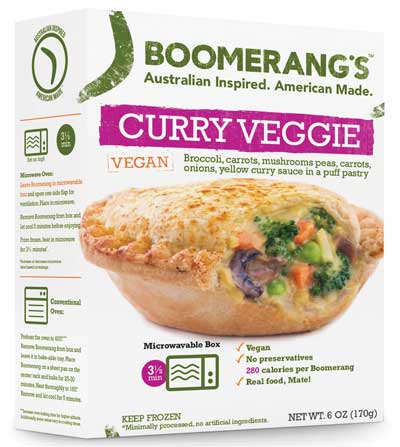 Also growing in popularity are the frozen Australian-inspired small meat pies manufactured by Boomerang’s Foods. “It’s like a handheld pot pie,” explains the company’s CEO, Jack Fennell. “I was living in Australia, and my first day there I actually had a meat pie and had one of those moments when I thought to myself, ‘Why don’t we get these back home?’”
Also growing in popularity are the frozen Australian-inspired small meat pies manufactured by Boomerang’s Foods. “It’s like a handheld pot pie,” explains the company’s CEO, Jack Fennell. “I was living in Australia, and my first day there I actually had a meat pie and had one of those moments when I thought to myself, ‘Why don’t we get these back home?’”
Back in Texas, Fennell and his business partner began making Boomerang’s handheld pies in 2012, after hiring a pie maker from Australia with 20 years in the meat pie business. Today, the clean label frozen pies come in 10 or so “Americanized flavors,” including Southwest Chicken, Steak & Potato, Mac & Cheese, Pepperoni, Currie Veggie, and the newest flavor, Chicken Classic. Two breakfast handheld meat pies are also available: Sausage, Egg & Cheese and Tex-Mex Scramble. The products have no additives or preservatives, and the meat used is antibiotic-free.
“If you look at the age breakdown of who eats our product, it’s the entire spectrum,” Fennell says. “Young kids love the Mac & Cheese and Pepperoni pies, and Baby Boomers buy our products because it’s comfort food.” While the product can be consumed on the go, Fennell says he knows from customer feedback that the pies are also eaten at the dinner table, with each family member able to have his or her favorite.
Stuffed pastries popular in Latin American countries, Spain, Portugal, and the Philippines, empanadas are now taking the United States by storm. Popularized at Argentinian restaurants such as 5411 Empanadas, which began as a food truck in Chicago and now has five trendy restaurants (including one in Houston and one in Miami), these pastries can be baked or fried and are appetizer- or entrée-sized (5411 Empanadas 2017).
Limited only by the chef’s imagination, fillings for empanadas include ground beef spiced with cumin and mixed with chopped green olives, onion, and hard-cooked eggs; bacon, date, and goat cheese; shrimp spiced with cayenne and mixed with cheese, onion, and tomato sauce; and infinite other possibilities. Breakfast-style variations have become increasingly common as well. Meat-filled empanadas are usually dipped in chimichurri sauce, in which parsley, garlic, chili pepper, oregano, and other ingredients are combined with olive oil and vinegar.
Whole Foods offers heat-and-eat empanadas with a small container of chimichurri sauce in the refrigerated case next to other fresh-prepared foods. But frozen empanadas are also becoming more widely available at U.S. supermarkets. Goya Foods offers Beef Empanadas, four to a package, made of ground beef, bell pepper, tomato, and onion. New from Goya, Chicken Empanadas combine chicken with the same ingredients.
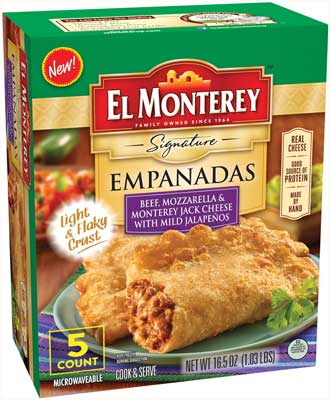 Made by Ruiz Foods, the El Monterey brand also offers new Signature Empanadas, five to a box; the handmade empanadas feature beef and mozzarella and Monterey Jack cheeses flavored with mild jalapeños (El Monterey 2017).
Made by Ruiz Foods, the El Monterey brand also offers new Signature Empanadas, five to a box; the handmade empanadas feature beef and mozzarella and Monterey Jack cheeses flavored with mild jalapeños (El Monterey 2017).
Empanadas are a delicious, trending product with untapped opportunities in the better-for-you frozen space, says Kelly Swette, cofounder of Sweet Earth Natural Foods. That’s why the company will be debuting an empanada line in 2018, samples of which were shown at Natural Products Expo East in Baltimore in September. The line will feature several varieties, including the Cubano and the Moroccan (a vegan product).
The 4.2-ounce empanadas can be eaten either as an entrée or a snack, Swette points out. “The distinction between snacks and meals really is blurring,” she says. “Because these are filling—the Cubano has 15 grams of protein—we have found that they can be a meal, but they can also be a snack or an appetizer. With our empanadas, we are continuing the innovation that retailers are expecting from us.”
Wraps on the Rise
Long a part of mainstream American cuisine, burritos remain among the most popular wrapped handheld products that are eaten hot. In the frozen non-breakfast segment, Amy’s Kitchen continues to lead in offerings of gluten-free, organic, and vegan burritos. The selection includes the Gluten-free Black Bean & Quinoa Burrito (vegan), the Light & Lean Bean & Cheese Burrito, the Light in Sodium Cheddar Cheese Burrito, and the Non-Dairy Bean & Rice Burrito (vegan), to name just a few.
Sweet Earth Natural Foods gives consumers a choice of eight unique vegetarian burritos, each influenced by a different global cuisine tradition: The Brazilian, The Kyoto (vegan), The Mayan, The Greek, The Santa Cruz, The Curry Tiger (vegan), The Peruvian, and The Anasazi (vegan). The Peruvian, for example, contains black beans, red quinoa, goat cheese, roasted corn, and spirulina.
“The Peruvian people used to harvest spirulina from the lakes, and they used quinoa, corn, black beans, and goat cheese,” Swette says. “The only thing that we added was our traditional seitan, which gives it additional protein and a little more texture.”
When she and her husband started the company in 2011, the selection of frozen burritos available in the market was limited. “Everything was beans and rice and featured an animal protein or maybe tofu,” she remembers. “So we started out not putting rice in any of them and making sure that we went after nutrient diversity as well as nutrient density.”
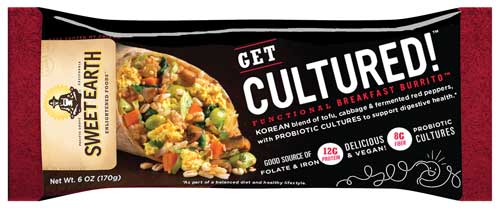 In 2014, Sweet Earth added its line of four “functional food” breakfast burritos: Get Cultured!, Get Focused!, Lighten Up!, and Protein Lover’s. “People have different need states in the morning, and they’re looking at food as a functional ingredient—food as medicine and as an alternative to a supplement in the morning,” Swette explains. “It’s been an incredibly successful line for us.” The Get Cultured!, for example, is a Korean-inspired vegan blend of seasoned tofu, cabbage, fermented red pepper, edamame, and ginger that includes a billion probiotic cultures.
In 2014, Sweet Earth added its line of four “functional food” breakfast burritos: Get Cultured!, Get Focused!, Lighten Up!, and Protein Lover’s. “People have different need states in the morning, and they’re looking at food as a functional ingredient—food as medicine and as an alternative to a supplement in the morning,” Swette explains. “It’s been an incredibly successful line for us.” The Get Cultured!, for example, is a Korean-inspired vegan blend of seasoned tofu, cabbage, fermented red pepper, edamame, and ginger that includes a billion probiotic cultures.
Wraps influenced by Indian cuisine are particularly hot today, as the growth of one Chicago-based restaurant chain illustrates. “Growing up in Bombay, we had these street stalls like in Mexico City and other emerging markets where they have a little coal-fired store and a couple of skewers of meat, with bread on the side,” remembers Ali Dewjee, who co-owns Bombay Wraps, which began as a food truck and is about to open its third fast-casual restaurant. “You could go up to them and say you wanted the chicken or the beef, and they would put it on the bread with some onions. It was the best portable, great-tasting, inexpensive sandwich one could find, whether for lunch or a late-night dinner.”
Dewjee and his wife started Bombay Wraps seven years ago with eight menu items featuring such fillings as tandoori chicken, cheese paneer, and chicken tikka masala, wrapped in an Indian flatbread, either paratha (a flaky thick flatbread) or roti, which is lighter and thinner. “We add a little bit of pickled onions for crunch and a nice finish at the end and cilantro mint chutney, just like we grew up eating it,” he says.
While his customers include people of Indian descent, a large proportion are not. “We went for a certain mindset—someone who is open to new adventures, someone who is open to trying different things. Food and music are such a great gateway into a culture.”
Frozen Indian wraps, as opposed to samosas, aren’t easy to find in mainstream supermarkets, but Hayward, Calif.–based Sukhi’s has a line called Street Wraps in flavors such as Paneer Tikka Masa, Chicken Vindaloo, Tandoori Spiced Chicken, and Chicken Tikka Masala (Sukhi’s 2017).
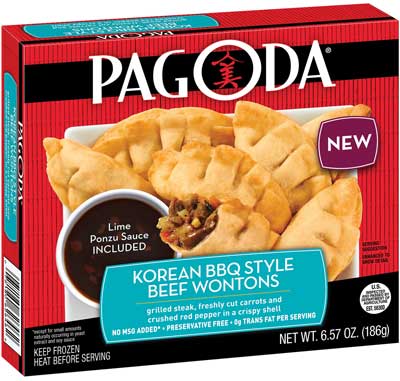 Old favorites among American consumers, egg rolls and wontons used to be regarded as appetizers but are now often eaten as snacks and light meals. Schwan’s Co.’s frozen retail Pagoda brand now offers its 100% White Meat Chicken Egg Rolls, Pork & Shrimp Egg Rolls, and other items in the line with a new sweet chili sauce, reflecting the trend toward pairing sweet and savory. In February of this year, the company introduced two new wonton flavors as well: Honey Sesame Chicken and Korean BBQ Style Beef.
Old favorites among American consumers, egg rolls and wontons used to be regarded as appetizers but are now often eaten as snacks and light meals. Schwan’s Co.’s frozen retail Pagoda brand now offers its 100% White Meat Chicken Egg Rolls, Pork & Shrimp Egg Rolls, and other items in the line with a new sweet chili sauce, reflecting the trend toward pairing sweet and savory. In February of this year, the company introduced two new wonton flavors as well: Honey Sesame Chicken and Korean BBQ Style Beef.
“More than 50% of Millennials are exploring Asian flavors beyond traditional Chinese,” notes a spokeswoman for Schwan’s. “These new wontons are a great example of our commitment to flavor exploration driven by Millennials, a culturally diverse group that wants more ethnic and global cuisine at retail.”
Pitas, Shells, Sticks, and Buns
In the frozen sandwich subcategory in the United States, Kangaroo Brands’ Sandwich Bros. of Wisconsin division stands out. In the non-breakfast segment, which experienced flat sales overall, sales of the company’s frozen sandwiches increased 17.4% in the past year, IRI data reveal (IRI 2017). The pita, or pocket flatbread, sandwiches include Angus Cheeseburgers, Gyro Sliders (seasoned ground beef with herbed yogurt cheese), Chicken Melts, and a new product, Meatball Sliders (Sandwich Bros. 2017).
“Moms just love our products, especially on the days when their kids have activities,” says Leigh Thornberry, director of marketing for Kangaroo Brands. “You can give kids a cheeseburger for a quick dinner before they’re off for football practice and then give them more to eat later.”
Thornberry notes that because the pocket sandwiches are high in protein and about 160 calories per serving, they are popular with people who are trying to lose weight. “With the movement toward healthier eating, the pocket flatbread we use is a great portion controller,” she explains. “So we have a huge fan base among Weight Watchers members. Once they grab hold of a yummy product that’s working for them, they share it all over the place.”
Always dominant in the handheld category, manufacturers of frozen Mexican cuisine produce an abundance of portable products beyond burritos, including tamales, quesadillas, chimichangas and, of course, tacos. Leveraging the street food craze, Circle Foods makes Nuevo Grille brand Street Tacos, which consist of corn tortillas filled with pork carnitas and tomatillo salsa. Today, street food has the cachet of authenticity, so it’s not surprising that food manufacturers would incorporate the word “street” into the names of their lines and products.
New from Ruiz Foods, the second largest supplier of non-breakfast frozen handhelds after Nestlé, are El Monterey Bigger! Bolder! Taquitos in two flavors: Chicken & Monterey Jack and Beef, Cheddar & Monterey Jack. Available at Meijer stores, these products are touted as twice the size of the brand’s standard taquitos (ElMonterey.com 2017).
Also gaining more shelf space in the freezer case are precooked hamburgers and cheeseburgers on buns, such as Conagra Brands’ Banquet Cheeseburger Sliders and Tyson Foods’ Ball Park Flame Grilled Sliders. These microwavable burgers target families that are too busy to get out the grill or frying pan.
Perhaps the ultimate in handheld convenience, corn dogs manufactured by Foster Farms now come in several varieties, including Honey Crunchy, Gluten Free Honey Crunchy, Chili Cheese, and Cheese and Jalapeño. Each of the chicken frankfurter corn dogs contains 7 grams of protein, and no hormones or steroids are used in their production, the packaging states (Foster Farms 2017).
Though normally associated with state fairs and carnivals, corn dogs in the restaurant sector have gone gourmet. Fox & Son Fancy Corndogs in Philadelphia, for instance, offers a Sweet Potato Chorizo Corn Dog (Fox and Son Philly 2017).
Despite the display of imagination in the handheld category, there is still room for innovation throughout all segments. Given consumers’ predisposition toward eating on the go and their willingness to try the new and different, this category could prove a good investment for a company that breaks the mold.









